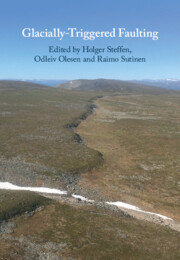Book contents
- Glacially-Triggered Faulting
- Glacially-Triggered Faulting
- Copyright page
- Contents
- Figures
- Tables
- Contributors
- Preface
- Part I Introduction
- Part II Methods and Techniques for Fault Identification and Dating
- Part III Glacially Triggered Faulting in the Fennoscandian Shield
- Part IV Glacially Triggered Faulting at the Edge and in the Periphery of the Fennoscandian Shield
- 15 Lateglacial and Postglacial Faulting in Denmark
- 16 Glacially Induced Faults in Germany
- 17 Glacially Induced Faulting in Poland
- 18 Soft-Sediment Deformation Structures in the Eastern Baltic Region
- Part V Glacially Triggered Faulting Outside Europe
- Part VI Modelling of Glacially Induced Faults and Stress
- Part VII Outlook
- Index
- References
17 - Glacially Induced Faulting in Poland
from Part IV - Glacially Triggered Faulting at the Edge and in the Periphery of the Fennoscandian Shield
Published online by Cambridge University Press: 02 December 2021
- Glacially-Triggered Faulting
- Glacially-Triggered Faulting
- Copyright page
- Contents
- Figures
- Tables
- Contributors
- Preface
- Part I Introduction
- Part II Methods and Techniques for Fault Identification and Dating
- Part III Glacially Triggered Faulting in the Fennoscandian Shield
- Part IV Glacially Triggered Faulting at the Edge and in the Periphery of the Fennoscandian Shield
- 15 Lateglacial and Postglacial Faulting in Denmark
- 16 Glacially Induced Faults in Germany
- 17 Glacially Induced Faulting in Poland
- 18 Soft-Sediment Deformation Structures in the Eastern Baltic Region
- Part V Glacially Triggered Faulting Outside Europe
- Part VI Modelling of Glacially Induced Faults and Stress
- Part VII Outlook
- Index
- References
Summary
Poland is in an intraplate area characterized almost everywhere by low recent tectonic activity. This does not imply, however, that earthquakes have not affected it, even in the – geologically speaking – recent geological past. This is due to Pleistocene glaciations, which left traces in the form of earthquake-induced deformed layers. The strongly deformed layers (seismites) as well as some fault zones with significant offsets crossing also Quaternary sediments can indicate fault (re-)activation due to glacial isostatic adjustment. We inventory and describe the five sites/areas in the intraplate northern and central parts of Poland where traces of glacial isostatic adjustment occur. We do not deal, however, with the mountain areas of southern Poland, because Alpine pressure and glacial isostatic adjustment may each, possibly jointly, have acted there as a trigger; distinguishing between traces left by them is not yet viable.
Keywords
- Type
- Chapter
- Information
- Glacially-Triggered Faulting , pp. 304 - 319Publisher: Cambridge University PressPrint publication year: 2021
References
- 2
- Cited by



